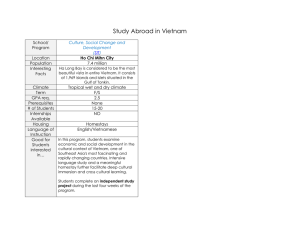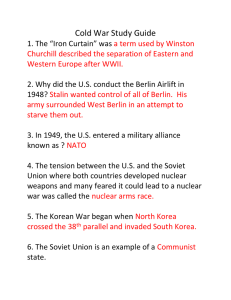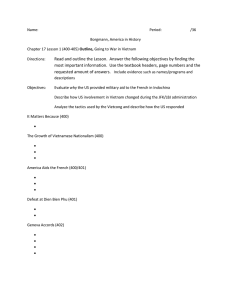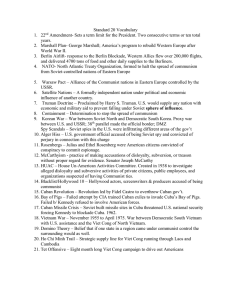East versus west: A Global Divide and a Cold War AP World History
advertisement
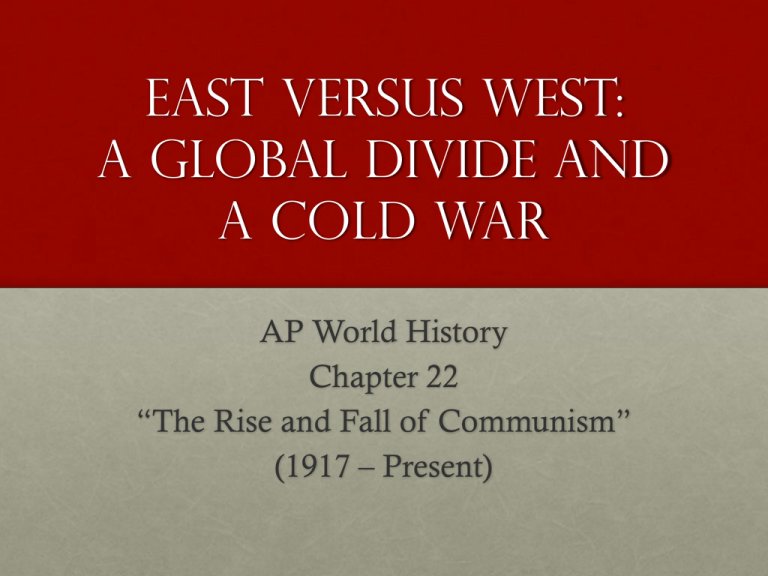
East versus west: A Global Divide and a Cold War AP World History Chapter 22 “The Rise and Fall of Communism” (1917 – Present) A Global Divide • Cold War = 1946-1991 • 2 global superpowers United States versus the Soviet Union • 2 global military alliances NATO versus the Warsaw Pact • The Iron Curtain = the Sovietcreated, heavily fortified border splitting non-Communist Western Europe and Communist Eastern Europe A Global Divide The Berlin Wall • Became a universal symbol of the Cold War • Built by East Germany (with Soviet backing) in 1961 to stop East Germans from fleeing to West Berlin Leaders During the Cold War United States Soviet Union Policy of Containment • The United States developed a new foreign policy = containment • Designed to stop the spread of communism • This policy led the U.S. to get involved in several Cold War conflicts: • Korean War • Vietnam War • Conflict in Afghanistan • Cuban Missile Crisis Korean War (1950-1953) • After WWII, Korea was divided at the 38th parallel • Northern half = to be temporarily occupied by the Soviet Union • Southern half = to be temporarily occupied by the U.S. • By 1948 = 2 separate governments had emerged • North Korea = Communist • South Korea = Democratic • By mid-1949 = both the United States and the Soviet Union had withdrawn all of their troops from North and South Korea Korean War (1950-1953) • June 1950 = North Korea invaded South Korea wanted to unify the country under a communist government • United Nations meets in response • Voted to condemn the invasion • Agreed to organize an army to oppose it • 16 countries contributed troops to UN army but 90% of those troops came from the U.S. • Leader of the UN army = Douglas MacArthur Korean War (1950-1953) • Brief game of back-and-forth followed by a long stalemate • First few months of war = North Koreans swept southward and conquered almost all of South Korea • September 1950 = UN forces launched a counterattack, pushed the North Koreans out of South Korea, and advanced until they had conquered almost all of North Korea • Communist China came to the aid of North Korea Chinese forces and North Koreans able to push UN forces back to a line near the 38th parallel Korean War (1950-1953) • July 1951 – July 1953 = stalemate along this line near the 38th parallel • July 1953 = truce was signed both sides agreed to divide Korea (once again) along the 38th parallel • 5 million deaths and mass devastation of much of Korea for what? “The Forgotten War” The Vietnam War (1955-1975): First Indochina War • Before WWII = France controlled Indochina (including Vietnam) • After the Japanese left Indochina following WWII = France wanted to regain control of Vietnam • A Vietnamese nationalist group had developed, however, that wanted an independent Vietnam = called the Vietminh • Leader = Ho Chi Minh • This group = communist • Supported by the Soviet Union and China First Indochina War • Vietminh and France could not agree on how to share power in Vietnam • 1946 = two sides went to war • U.S. sent military and financial aid to help France • French still couldn’t pull out a victory • May 1954 = French forces defeated by the Vietminh in the decisive battle at Dien Bien Phu First Indochina War • One month before this battle = the Vietminh, France, and U.S. met to negotiate a settlement to the Vietnam conflict • They agreed to divide Vietnam along the 17th parallel • Created a communist North Vietnam and a democratic South Vietnam • Division supposed to last until 1956 = when elections were to be held • Ngo Dinh Diem (leader of South Vietnam) rejected the proposed elections • Diem = weak and unpopular • Ho Chi Minh = VERY popular First Indochina War • Viet Cong = communist guerrillas in South Vietnam fought Diem in hopes of uniting Vietnam under Ho Chi Minh • Diem = weak and unpopular leader, even with his OWN people • 1963 = South Vietnamese military staged a coup in which Diem was killed • Thought that if he continued to be in power, the south would fall to the Communists • U.S. quietly approved of this coup The Vietnam War • By late 1963 = 16,000 American advisors were in Vietnam • 1964 = U.S. approved of secret South Vietnamese naval raids against North Vietnam • August 2, 1964 = U.S. President Lyndon Johnson announced that North Vietnam had fired on 2 U.S. ships off the coast of Vietnam U.S. Advisors in Vietnam • Incident never confirmed • President Johnson used it to increase American involvement in the war The Vietnam War • Congress passed the Gulf of Tonkin Resolution = gave the President broad war powers • March 1965 = Johnson sent first ground troops to Vietnam • By 1968 = more than 500,000 American troops were in Vietnam • South Vietnamese army = numbered 800,000 • North Vietnamese army and the Viet Cong = numbered 300,000 • China and Soviet Union sent aid, but no troops, to help North Vietnam The Vietnam War • Despite greater numbers and advanced technology, the Americans could not defeat the Communists • Viet Cong relied on mobility, surprise attacks, and guerilla warfare avoid open battle • As the war intensified, antiwar attitudes in the U.S. continued to spread The Tet Offensive • Early 1968 = the Tet Offensive = when the Viet Cong launched a major military offensive during the Vietnamese New Year holiday (Tet) • Did not capture any major cities • Bitter fighting made even more Americans realize, however, that years of U.S. involvement in Vietnam had failed to weaken the Viet Cong • Opposition to the war intensified Johnson did not run for reelection in 1968 City of Cholon after the Tet Offensive Ending the Vietnam War • Under President Richard M. Nixon, the U.S. began to withdraw troops • 1973 = South Vietnam, the U.S., and the Communists agreed to a cease-fire • U.S. withdrew the rest of its troops from Vietnam • 1975 = the war resumed North Vietnamese and Viet Cong forces defeated the South Vietnamese U.S. troops leaving North Vietnam Ending the Vietnam War • After 20 years of fighting in Vietnam: • Vietnam reunited under the Communists • 2 million deaths (58,000 were Americans) • 10 million South Vietnamese refugees • Large areas of Vietnam lay devastated Vietnam Memorial in Washington, D.C. Conflict in Afghanistan • 1978 = a Marxist party had taken over power in Afghanistan • Marxist leaders took steps to: • Implement radical land reforms • Liberate women • Problem = this upset conservative Muslims within the country and led to a large opposition movement • Soviet Union = intervened with its military Soviet Soldiers in Kabul, Afghanistan • Afraid that this new communist regime in Afghanistan would be overthrown and replaced by Islamic radicals • Got caught up in a war they could not win lasted from 1978 until 1989 Conflict in Afghanistan • U.S. = sent aid to the Afghan guerrillas to help them oust Soviet forces and end the communist regime in Afghanistan • “Operation Cyclone” = code name for the CIA program to arm, train, and finance the Afghan insurgents during their war against the Soviets • Soviet forces finally withdrew in 1989 • Afghan communist regime soon collapsed Afghan insurgent using a U.S. “stinger” missile The Cuban Missile Crisis • 1959 = Fidel Castro came to power in Cuba • Revolutionary nationalist • Liked Marxist ideas led him to establish a communist regime in Cuba in 1960 • Soviet Union = pumped! 1st time a country had set up a communist government without the Red Army • Nationalized American assets in Cuba = brought them under ownership of the Cuban government • Provoked a lot of U.S. hostility • U.S. stopped all aid to Cuba AND all imports of Cuban sugar The Cuban Missile Crisis • April 1961 = Bay of Pigs Invasion • CIA funded, trained, armed, and transported 1300 Cuban exiles to invade Cuba • Landed at the Bay of Pigs • Goal = to overthrow Castro • Invasion = a disaster; President Kennedy was humiliated • Major Result = Castro asked the Soviet Union to provide him with weapons to protect Cuba against America The Cuban Missile Crisis • Leader of the Soviet Union at this time = Nikita Khrushchev • Feared that American aggression against Cuba would lead to the loss of this new communist ally in the Caribbean • He secretly deployed nucleartipped Soviet missiles to Cuba thought this would stop any further U.S. action against Castro • Soviet Union quickly and secretly built missile bases in Cuba The Cuban Missile Crisis • October 1962 = missiles discovered by the U.S. • For 13 days = American forces blockaded Cuba and prepared for an invasion • Agreement struck between President Kennedy and Premier Khrushchev • Both knew nuclear war would be absolutely devastating • Soviet Union agreed to remove ALL missiles from Cuba • U.S. promised to not invade Cuba
